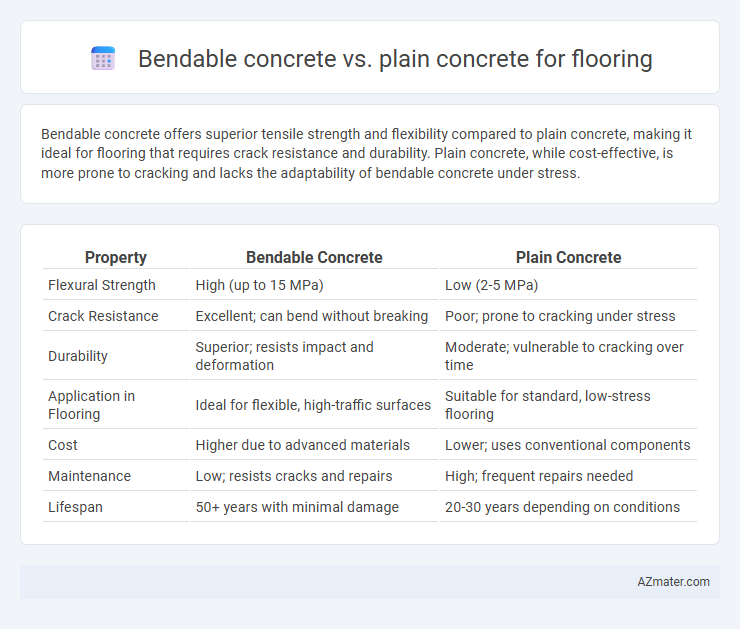Bendable concrete offers superior tensile strength and flexibility compared to plain concrete, making it ideal for flooring that requires crack resistance and durability. Plain concrete, while cost-effective, is more prone to cracking and lacks the adaptability of bendable concrete under stress.
Table of Comparison
| Property | Bendable Concrete | Plain Concrete |
|---|---|---|
| Flexural Strength | High (up to 15 MPa) | Low (2-5 MPa) |
| Crack Resistance | Excellent; can bend without breaking | Poor; prone to cracking under stress |
| Durability | Superior; resists impact and deformation | Moderate; vulnerable to cracking over time |
| Application in Flooring | Ideal for flexible, high-traffic surfaces | Suitable for standard, low-stress flooring |
| Cost | Higher due to advanced materials | Lower; uses conventional components |
| Maintenance | Low; resists cracks and repairs | High; frequent repairs needed |
| Lifespan | 50+ years with minimal damage | 20-30 years depending on conditions |
Introduction to Bendable vs Plain Concrete Flooring
Bendable concrete flooring incorporates engineered fibers that improve tensile strength and flexibility, reducing cracking compared to traditional plain concrete. Plain concrete flooring, composed primarily of cement, water, and aggregates, offers rigidity but is prone to cracking under stress or ground movement. The enhanced durability and improved load distribution of bendable concrete make it a superior choice for flooring applications requiring long-term resilience.
Key Material Differences: Bendable and Plain Concrete
Bendable concrete incorporates engineered fibers or polymer reinforcements to enhance tensile strength and flexibility, allowing it to resist cracking under stress, unlike plain concrete which relies solely on cement, aggregates, and water and is prone to brittle failure. The microstructure of bendable concrete includes admixtures that enable strain-hardening behavior, improving durability for flooring applications subjected to dynamic loads. Plain concrete's homogeneous matrix offers high compressive strength but lacks the ductility and crack resistance found in bendable concrete.
Strength and Durability Factors
Bendable concrete, also known as engineered cementitious composite, offers superior tensile strength and crack resistance compared to plain concrete, making it highly durable for flooring applications. Its fiber-reinforced matrix allows for controlled flexibility and enhanced impact resistance, reducing maintenance costs over time. Plain concrete, while strong in compression, is prone to cracking under tensile stress, leading to potential structural weaknesses and shorter lifespan in high-traffic or dynamic load environments.
Flexibility and Crack Resistance
Bendable concrete offers superior flexibility compared to plain concrete, making it an ideal choice for flooring applications prone to structural movement or ground shifts. Its enhanced crack resistance is achieved through engineered fibers that distribute stress evenly, significantly reducing the risk of surface fissures and prolonging floor durability. Plain concrete, while strong under compression, is brittle and more susceptible to cracking, especially under dynamic loads or thermal expansion, limiting its effectiveness in flexible flooring installations.
Installation Process Comparison
Bendable concrete flooring requires specialized installation techniques involving layered reinforcement with fibers or mesh to enhance flexibility and prevent cracking, unlike plain concrete which relies on rigid pouring and curing processes. The installation of bendable concrete demands precise mixing ratios and careful placement to ensure the material's ductile qualities are fully effective. Plain concrete installations are generally faster and less complex but may lead to more frequent repairs due to brittleness under stress.
Cost Analysis: Initial and Long-Term
Bendable concrete flooring typically has a higher initial cost compared to plain concrete due to advanced materials and manufacturing processes involved. Over time, bendable concrete demonstrates superior durability and flexibility, leading to significantly lower maintenance and repair expenses. Plain concrete often incurs higher long-term costs due to cracking and frequent repairs, making bendable concrete a cost-effective solution despite the upfront investment.
Sustainability and Environmental Impact
Bendable concrete significantly reduces environmental impact compared to plain concrete by enhancing durability and minimizing cracking, which extends the lifespan of flooring and reduces the need for frequent repairs. Its composition often incorporates recycled materials and requires less raw material consumption, contributing to lower carbon emissions during production. By improving structural resilience, bendable concrete lowers maintenance demands and waste generation, promoting more sustainable building practices in flooring applications.
Maintenance and Lifespan
Bendable concrete flooring exhibits superior durability and crack resistance compared to plain concrete, significantly reducing maintenance frequency and costs. Its enhanced tensile strength allows it to flex under stress, minimizing surface damage and extending the lifespan of flooring installations to over 50 years. In contrast, plain concrete often requires regular repairs due to cracking and surface wear, shortening its effective lifespan to around 20-30 years under typical usage conditions.
Best Use Cases for Each Concrete Type
Bendable concrete, characterized by its high tensile strength and flexibility, is best suited for flooring applications requiring enhanced crack resistance and durability in dynamic or heavy-load environments such as industrial warehouses and outdoor pavements. Plain concrete, known for its compression strength and cost-effectiveness, performs optimally in static flooring scenarios like residential patios and interior floors where minimal movement occurs. Choosing between bendable and plain concrete depends on factors such as load stress, exposure to environmental changes, and required longevity in flooring projects.
Choosing the Right Flooring Solution
Bendable concrete offers superior flexibility and crack resistance compared to plain concrete, making it an ideal choice for flooring in environments subject to movement or heavy loads. Plain concrete provides affordability and high compressive strength but lacks the tensile properties that prevent cracking under stress. Selecting between bendable and plain concrete depends on factors like floor usage, load conditions, and long-term durability requirements to ensure the right flooring solution.

Infographic: Bendable concrete vs Plain concrete for Flooring
 azmater.com
azmater.com